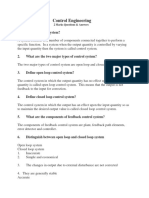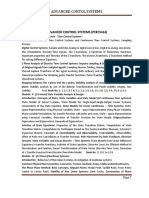Introduction To Digital Control Systems - Lecture Notes
Uploaded by
sridharparthipanIntroduction To Digital Control Systems - Lecture Notes
Uploaded by
sridharparthipanDigital Control
Module 1
Lecture 1
Module 1: Introduction to Digital Control Lecture Note 1
Digital Control System
A digital control system model can be viewed from dierent perspectives including control algorithm, computer program, conversion between analog and digital domains, system performance etc. One of the most important aspects is the sampling process level. In continuous time control systems, all the system variables are continuous signals. Whether the system is linear or nonlinear, all variables are continuously present and therefore known (available) at all times.A typical continuous time control system is shown in Figure 1.
Command input r (t) + Error e( t ) Controller Control input u(t) Plant Output y (t)
Sensor
Figure 1: A typical closed loop continuous time control system In a digital control system, the control algorithm is implemented in a digital computer. The error signal is discretized and fed to the computer by using an A/D (analog to digital) converter. The controller output is again a discrete signal which is applied to the plant after using a D/A (digital to analog) converter. General block diagram of a digital control system is shown in Figure 2. e(t) is sampled at intervals of T . In the context of control and communication, sampling is a process by which a continuous time signal is converted into a sequence of numbers at discrete time intervals. It is a fundamental property of digital control systems because of the discrete nature of operation of digital computer. Figure 3 shows the structure and operation of a nite pulse width sampler, where (a) represents the basic block diagram and (b) illustrates the function of the same. T is the sampling period and p is the sample duration. I. Kar 1
Digital Control
Module 1
Lecture 1
Command input r (t) +
Error A/D e( t )
Computer (control algorithm)
D/A
u (t)
Output Plant y (t)
Sensor
Figure 2: General block diagram of a digital control system
e (t) p (t) e (t) p (t) Pulse train generator T p (t) e p (t) e (t) Pulse amplitude modulation t e p (t) p t
(a)
(b)
Figure 3: Basic structure and operation of a nite pulse width sampler
In the early development, an analog system, not containing a digital device like computer,in which some of the signals were sampled was referred to as a sampled data system. With the advent of digital computer, the term discrete-time system denoted a system in which all its signals are in a digital coded form. Most practical systems today are of hybrid nature, i.e., contains both analog and digital components. Before proceeding to any depth of the subject we should rst understand the reason behind going for a digital control system. Using computers to implement controllers has a number of advantages. Many of the diculties involved in analog implementation can be avoided. Few of them are enumerated below. 1. Probability of accuracy or drift can be removed. 2. Easy to implement sophisticated algorithms. 3. Easy to include logic and nonlinear functions. I. Kar 2
Digital Control 4. Recongurability of the controllers.
Module 1
Lecture 1
1.1
A Naive Approach to Digital Control
One may expect that a digital control system behaves like a continuous time system if the sampling period is suciently small. This is true under reasonable assumptions. A crude way to obtain digital control algorithms is by writing the continuous time control law as a dierential equation and approximating the derivatives by dierences and integrations by summations. This will work when the sampling period is very small. However various parameters, like overshoot, settling time will be slightly higher than those of the continuous time control. Example: PD controller A continuous time PD controller can be discretized as follows: de(t) dt [e(kT ) e((k 1)T )] u(kT ) = Kp e(kT ) + Kd T u( t ) = K p e ( t ) + K d where k represents the discrete time instants and T is the discrete time step or the sampling period. We will see later the control strategies with dierent behaviors, for example deadbeat control, can be obtained with computer control which are not possible with a continuous time control.
1.2
Aliasing
Stable linear systems have property that the steady state response to sinusoidal excitations is sinusoidal with same frequency as that of the input. But digital control systems behave in a much more complicated way because sampling will create signals with new frequencies. Aliasing is an eect of the sampling that causes dierent signals to become indistinguishable. Due to aliasing, the signal reconstructed from samples may become dierent than the original continuous signal. This can drastically deteriorate the performance if proper care is not taken.
Inherently Sampled Systems
Sampled data systems are natural descriptions for many phenomena. In some cases sampling occurs naturally due to the nature of measurement system whereas in some cases it occurs because information is transmitted in pulsed form. The theory of sampled data systems thus has many applications. 1. Radar: When a radar antenna rotates, information about range and direction is naturally obtained once per revolution of the antenna. 2. Economic Systems: Accounting procedures in economic systems are generally tied to the calendar. Information about important variables is accumulated only at certain times, I. Kar 3
Digital Control
Module 1
Lecture 1
e.g., daily, weekly, monthly, quarterly or yearly even if the transactions occur at any point of time. 3. Biological Systems: Since the signal transmission in the nervous system occurs in pulsed form, biological systems are inherently sampled. All these discussions indicate the need for a separate theory for sampled data control systems or digital control systems.
How Was Theory Developed ?
1. Sampling Theorem: Since all computer controlled systems operate at discrete times only, it is important to know the condition under which a signal can be retrieved from its values at discrete points. Nyquist explored the key issue and Shannon gave the complete solution which is known as Shannons sampling theorem. We will discuss Shannons sampling theorem in proceeding lectures. 2. Dierence Equations and Numerical Analysis: The theory of sampled-data system is closely related to numerical analysis. Dierence equations replaced the dierential equations in continuous time theory. Derivatives and integrals are evaluated numerically by approximating them with dierences and sums. 3. Transform Methods: Z-transform replaced the role of Laplace transform in continuous domain. 4. State Space Theory: In late 1950s, a very important theory in control system was developed which is known as state space theory. The discrete time representation of state models are obtained by considering the systems only at sampling points.
I. Kar
You might also like
- Electronics and Communication Engineering Resume Samples For Freshers100% (1)Electronics and Communication Engineering Resume Samples For Freshers2 pages
- State Space Analysis of Digital Control SystemNo ratings yetState Space Analysis of Digital Control System30 pages
- CHAPTER 1: Introduction To Discrete-Time Control Systems Digital Control SystemsNo ratings yetCHAPTER 1: Introduction To Discrete-Time Control Systems Digital Control Systems6 pages
- Nagoor Kani-Control System Engineering-RBA (2013)100% (1)Nagoor Kani-Control System Engineering-RBA (2013)396 pages
- Mathematical Modelling of Sampling ProcessNo ratings yetMathematical Modelling of Sampling Process6 pages
- Intelligent Electronic Devices in Substation: Presentation OnNo ratings yetIntelligent Electronic Devices in Substation: Presentation On26 pages
- Stability of Electric Drives: Dr. K. R. RajagopalNo ratings yetStability of Electric Drives: Dr. K. R. Rajagopal9 pages
- Modelling of AGC of Two Area Power System in Matlab Software Part-1No ratings yetModelling of AGC of Two Area Power System in Matlab Software Part-120 pages
- Signals and Systems by Sanjay Sharma PDF Download33% (3)Signals and Systems by Sanjay Sharma PDF Download4 pages
- Describing Function: Analysis of Nonlinear SystemsNo ratings yetDescribing Function: Analysis of Nonlinear Systems12 pages
- Ee3512 Control and Instrumentation Laboratory100% (2)Ee3512 Control and Instrumentation Laboratory2 pages
- Pulse Transfer Function and Manipulation of Block Diagrams: The Output Signal Is Sample To ObtainNo ratings yetPulse Transfer Function and Manipulation of Block Diagrams: The Output Signal Is Sample To Obtain41 pages
- Control Engineering: 2 Marks Questions & Answers100% (1)Control Engineering: 2 Marks Questions & Answers16 pages
- Advantages of Angle Modulation Compared With Amplitude Modulation33% (3)Advantages of Angle Modulation Compared With Amplitude Modulation3 pages
- CHAPTER 1: Introduction To Discrete-Time Control Systems Digital Control SystemsNo ratings yetCHAPTER 1: Introduction To Discrete-Time Control Systems Digital Control Systems6 pages
- Chapter 2 Discrete Data Control SystemsNo ratings yetChapter 2 Discrete Data Control Systems78 pages
- Computer Implementation of Control Systems: Karl-Erik Årzen, Anton CervinNo ratings yetComputer Implementation of Control Systems: Karl-Erik Årzen, Anton Cervin58 pages
- Computer Implementation of Control Systems: Karl-Erik Årzen, Anton CervinNo ratings yetComputer Implementation of Control Systems: Karl-Erik Årzen, Anton Cervin58 pages
- Virtual Telepresence and Gesture Controlled RobotNo ratings yetVirtual Telepresence and Gesture Controlled Robot7 pages
- Regulated Power Supply-Block Diagram, Circuit Diagram, WorkingNo ratings yetRegulated Power Supply-Block Diagram, Circuit Diagram, Working17 pages
- SUB: Request For Rejoining As Assistant Professor-REGNo ratings yetSUB: Request For Rejoining As Assistant Professor-REG1 page
- Electronics and Communication Engineering Resume Samples For FreshersNo ratings yetElectronics and Communication Engineering Resume Samples For Freshers2 pages
- Transmitter Section: VCC - Bar VCC - BarNo ratings yetTransmitter Section: VCC - Bar VCC - Bar2 pages









































































